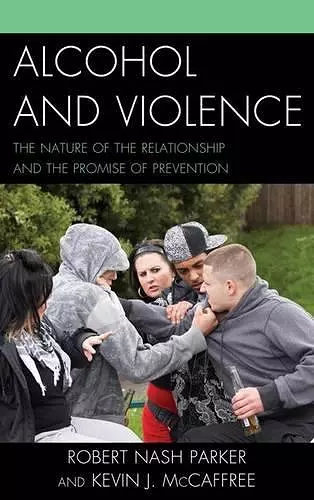Alcohol and Violence
The Nature of the Relationship and the Promise of Prevention
Robert Nash Parker author Kevin J McCaffree author
Format:Paperback
Publisher:Lexington Books
Published:23rd May '14
Currently unavailable, and unfortunately no date known when it will be back
This paperback is available in another edition too:
- Hardback£98.00(9780739180112)

Many people have experienced or witnessed situations in which people drinking alcohol get aggressive, obnoxious, and violent. Scientific research has shown evidence of a relationship between alcohol and violence, and even evidence that alcohol plays a role in causing violent and aggressive responses. The book explores a number of aspects of this relationship. If you have been drinking are you more likely to be a victim of crime? If victimized, does drinking alcohol make you more likely to be injured? How does availability of alcohol in the community influence rates of violence among Mexican American youth? Does advertising that links sex and alcohol result in higher rates of sexual assault in Latino neighborhoods? How do elementary school children react to experimentation with drugs, alcohol, and aggression? Do countries outside the United States have alcohol and violence problems, and do these impact men and women differently? We presents original research that shows the depths and conditions under which alcohol and violence are linked, further strengthening the evidence that alcohol use and availability is an important factor in violence in our cities, neighborhoods, school, and homes. The good news is that we regulate alcohol use and availability effectively, with a body of established laws and procedures. We can, therefore, find ways using this existing system to develop new ways to prevent the alcohol related violence studied here. The second half of the book begins this task by laying out the principles of environmental prevention, a strategy that has been very successful in a number of health and safety related domains. The next four chapters show just how environmental prevention strategies have worked, and worked very effectively, to lower rates of violence by reducing alcohol availability and alcohol consumption. The research reported here shows communities different approaches and mechanisms to achieve reductions in violence, and they provide a road map for communities everywhere to follow suit and reduce alcohol related violence. Reducing violence can be accomplished, everyone can do it if they work together, and the result is a safer and better society.
This is careful scholarship, a great book, and a fundamental contribution to the literature on alcohol and violence. Through wide ranging consideration of theory, sophisticated understanding of measurement and method, and recognition of the practical importance of harm reduction, Parker and McCaffree address a complex relationship often left to the periphery of criminology and sociology. The series of studies presented by the authors coalesces nicely to provide the reader with evidence about the alcohol-violence relationship and about the effects on violence of alcohol policy that cannot be ignored. From a school-based mental health intervention among adolescents, to raising the minimum drinking age, to an outright ban on alcohol in one town, the authors reveal the power of policy interventions to reduce alcohol-related aggression, violence, and other negative outcomes. -- William Alex Pridemore, Indiana University
In this comprehensive and theoretically grounded book, Parker and McCaffree make a compelling case for the need to ‘bring booze back in’ to the study of crime and violence. Using an impressive range of data sources and a variety of analyses, the authors make a very strong case for their central thesis that alcohol is causally related to violence. Alcohol-related control policies of various types are also shown to help reduce violence, offering potential avenues for relatively 'easy' interventions in the form of environmental changes to improve crime outcomes. Overall, in this book Parker and McCaffree make a most important contribution to criminology and surely will help to (re)direct scholars’ attention to the pivotal, yet largely ignored, role that alcohol plays for many forms of criminal violence. -- Amie L. Nielsen, University of Miami
Alcohol and Violence is a welcome contribution to the limited literature on this subject. Community members and program administrators are well aware that neighborhoods impacted by violence often have easy access to alcohol—yet are often challenged to make this case when trying to regulate and restrict the sale of alcohol in their communities. This work demonstrates the promise that policy and regulatory efforts hold for reducing violence in neighborhoods. I recommend it for all researchers, evaluators, and program staff working on this issue. -- Linda M. Bosma, Bosma Consulting, LLC
Sociologist Parker (Univ. of California, Riverside) and PhD student McCaffree join with coauthors on many chapters in this research monograph to explore the harm caused by, and environmental prevention strategies for, alcohol—the 'most important' drug for involvement with assault and homicide. Part 1 examines the nature of the relationship between alcohol and violent victimization; violence among Mexican American youth; sexually explicit alcohol advertising aimed at Latinos; adolescent mental health; and cross-national contexts. Part 2 examines prevention through the framework of environmental prevention, which means restricting access to alcohol (changing people's attitudes about alcohol is secondary, at best). With mixed success, the authors disavow a 'neo-Prohibitionist' label while reporting on the effects of raising the drinking age, banning alcohol in Barrow, Alaska, decreasing alcohol outlet density, and responsible beverage service (bartenders monitoring customer consumption). Chapters generally resemble journal article format, with contemporary literature reviews setting up model specification and analysis of 1990s data in detailed tables, followed by discussion. Contextualization of issues is good, literature reviews are impressive, and discussion is helpful (even for those having different viewpoints). Conclusions highlight the problems of alcohol while being nuanced, qualified, and sometimes surprisingly narrow. Summing Up: Recommended. * CHOICE *
ISBN: 9780739197738
Dimensions: 228mm x 156mm x 18mm
Weight: 349g
230 pages